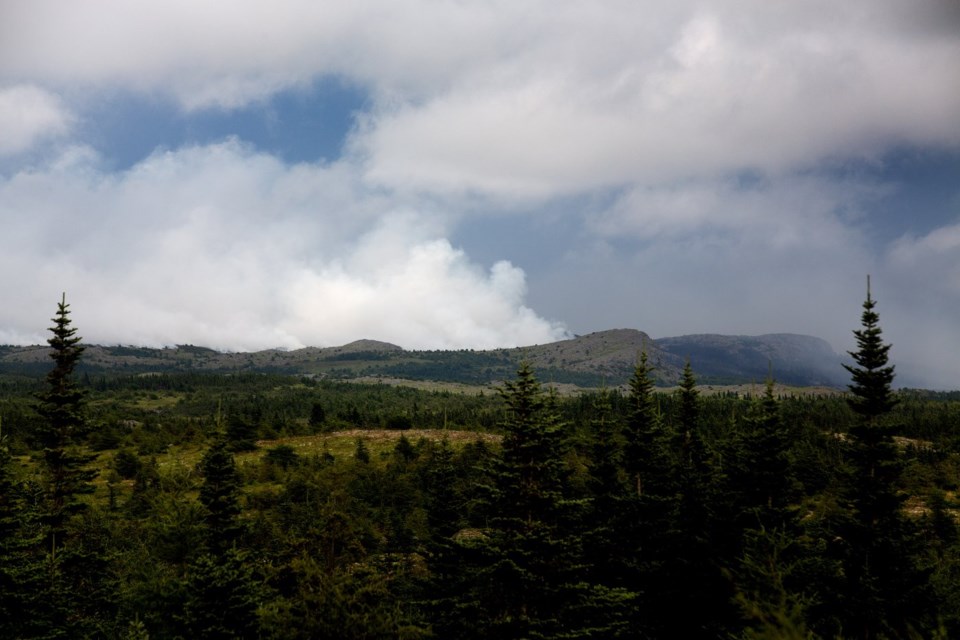Officials in Nova Scotia say a wildfire in the western part of the province has grown and could force people out of their homes, while cooler temperatures and low winds have helped firefighters in Newfoundland and Labrador.
The Long Lake wildfire is expected to grow, said Scott Tingley, manager of forest protection with Nova Scotia's Natural Resources Department.
It is spread over 11 square kilometres and moving toward West Dalhousie Road in Annapolis County. On Saturday, the fire was about eight square kilometres in size.
"These are not favourable firefighting conditions," Tingley told reporters Sunday. "It's very, very dry."
Two contracted helicopters were helping local firefighters along with crews from Prince Edward Island and Ontario, he said.
Environment Canada has forecast up to 15 millimetres of rain for Sunday night with showers ending Monday morning for Halifax and the surrounding areas.
Large swaths of Atlantic Canada have been reeling under drought-like conditions and sweltering heat.
Forest protection director Jim Rudderham said while cooler temperatures have helped firefighters, a significant amount of rain was needed to help quell the blazes.
"We don't begrudge any rain here, but it's really not going to do very much," he said.
"We need a few days of protracted, nice, steady rain. Remember now that ... the ground is so crusty that it’s going to take a good day just to break that crust and let the water go into the ground. So we need protracted rain."
The fire is burning about 135 kilometres northwest of Halifax, and officials declared a state of emergency in Annapolis County on Saturday. It has forced the evacuation of about 100 homes in the heavily wooded West Dalhousie area, about 125 kilometres west of Halifax.
However, on Sunday morning, a post from Nova Scotia officials said more evacuations were possible as the Long Lake wildfire spreads.
Tingley said the wildfire was within kilometres of the West Dalhousie Road area but given the intense smoke, it was hard to have a more accurate assessment.
So, officials have taken several steps, such as sprinklers, hoses and barriers to keep the community safe, he added.
Officials said they were also keeping a watch on Erin, the first Atlantic hurricane of 2025. The storm wasn’t expected to directly impact the U.S. East Coast, but by doubling or tripling in size it could bring rip currents all along the coast.
"That's a scary thought," Rudderham said. "We certainly have our meteorologists and our fire behaviour people watching very closely on anything that could happen with anomalies and weather. We'll continue to watch that and make plans accordingly."
Eleanor Olszewski, federal minister of emergency management, said she has approved a request for help from Nova Scotia to provide resources to tackle wildfires.
"Public Safety’s Government Operations Centre is working with the Canadian Armed Forces and other partners to deploy all necessary federal resources and ensure Nova Scotia has the support it needs," she said in a news release.
Meanwhile, cooler temperatures and low winds have helped firefighters in Newfoundland and Labrador with little growth in wildfires.
The largest wildfire, burning along the northwestern shore of Conception Bay, however, remained at a stubborn 95 square kilometres on Sunday. It is about the size of Paris, France.
The wildfire has destroyed about 100 houses and forced 3,000 people out of their homes.
"Today’s weather conditions, cooler temperatures and light winds will provide crews with a strong opportunity for suppression efforts," said a news release from the province's Fisheries, Forestry and Agriculture Department.
The Paddy's Pond wildfire, about 15 kilometres southwest of downtown St. John's, has been holding steady at just a little over three square kilometres in size, the release said.
The Martin Lake wildfire remains at 17 square kilometres and crews are tackling it with four water bombers and bucketing helicopters, it said.
There are seven active wildfires in Newfoundland and Labrador, with over 196 square kilometres of ground scorched.
Prime Minister Mark Carney expressed his gratitude to Canadian Armed Forces members helping fight the wildfires.
"To the members of the Canadian Armed Forces who risk their lives to keep Canadians safe — like those deployed to help fight wildfires and support communities in Newfoundland and Labrador this week — thank you, for everything," he said in a social media post.
In northern New Brunswick, an evacuation advisory has been lifted for the residents of Lavillette.
There are 39 active wildfires across New Brunswick with eight deemed out of control, said a news release from the province.
The Oldfield Road wildfire near Miramichi remains the largest one, measuring roughly 14 square kilometres.
"Even though some rain is expected in the coming days, wildfire danger remains high," said the news release.
"Current forecasts predict thunderstorms. Potential lightning strikes, combined with ongoing conditions, present a high risk for additional fires."
— With files from The Associated Press.
This report by The Canadian Press was first published Aug. 17, 2025.
The Canadian Press



